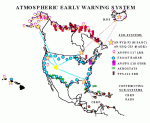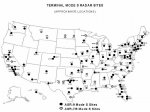This may be a question more suited for an actual military forum, but I thought I'd throw it out here in hopes someone could offer some insight.
Obviously, it's a huge matter of National Security that our Air Force/military keep a close watch on the skies above America, but just exactly how do they accomplish this? I mean, there's a LOT of airspace up there and keeping tabs on it all seems like a pretty daunting chore.
Sure, I know about NORAD - but aren't they busier keeping tabs on ballistic missile threats from hostile areas of the world? Or if they do indeed keep tabs on the airspace above us, how do they accomplish this? Do they have multiple radar sites around the country linked together and providing feeds back to their command center? Or do they just have a couple more powerful radar systems that do this? Or do they rely on AWACS aircraft covertly cruising around the country to provide them their surveillance?
What about, for example, when The President hops on board AF1 and decides to take a flight somewhere? I've watched AF1 on ADS-B a time or two, and it seems there's never any type of airborne surveillance aircraft flying around keeping an eye on the airspace around AF1. Are they likely there and just hiding their position data? I understand that MilAir aircraft have many capabilities, such as spoofing their ADS-B and whatnot. Just wondering what really takes place here.
I also understand my questions are pretty specific in nature, and while some people may know, they may not be able to answer, and that's okay.
Thanks!
Obviously, it's a huge matter of National Security that our Air Force/military keep a close watch on the skies above America, but just exactly how do they accomplish this? I mean, there's a LOT of airspace up there and keeping tabs on it all seems like a pretty daunting chore.
Sure, I know about NORAD - but aren't they busier keeping tabs on ballistic missile threats from hostile areas of the world? Or if they do indeed keep tabs on the airspace above us, how do they accomplish this? Do they have multiple radar sites around the country linked together and providing feeds back to their command center? Or do they just have a couple more powerful radar systems that do this? Or do they rely on AWACS aircraft covertly cruising around the country to provide them their surveillance?
What about, for example, when The President hops on board AF1 and decides to take a flight somewhere? I've watched AF1 on ADS-B a time or two, and it seems there's never any type of airborne surveillance aircraft flying around keeping an eye on the airspace around AF1. Are they likely there and just hiding their position data? I understand that MilAir aircraft have many capabilities, such as spoofing their ADS-B and whatnot. Just wondering what really takes place here.
I also understand my questions are pretty specific in nature, and while some people may know, they may not be able to answer, and that's okay.
Thanks!



